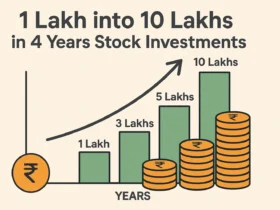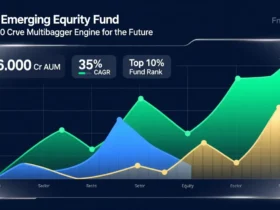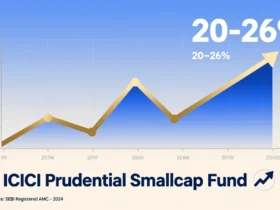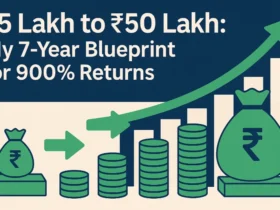What Are SIPs and Why They’re Your Ticket to Long-Term Wealth
Let’s start with the basics. A Systematic Investment Plan (SIP) is a simple yet powerful way to invest. Think of it like a monthly subscription to your financial future. You commit to investing a fixed amount—say, ₹5,000 or ₹10,000—every month into an investment vehicle like mutual funds, stocks, or exchange-traded funds (ETFs). Over time, this steady drip of money builds into a sizable pool, thanks to two magic ingredients: rupee cost averaging and compounding.
- Rupee Cost Averaging: When markets dip, your fixed amount buys more units. When prices rise, you buy fewer. This averages out your cost and reduces the stress of trying to “time” the market.
- Compounding: Your returns earn returns, and those returns earn even more returns. The longer you stay invested, the bigger this snowball grows.
Here’s a real-life analogy: Imagine planting a tree. You water it a little every day (your SIP contributions), and over the years, it grows into a towering giant (your wealth). That’s the beauty of SIPs—they reward patience and consistency.
Table of Contents
As billionaire investor Warren Buffett once said, “Someone’s sitting in the shade today because someone planted a tree a long time ago.” With SIPs, you’re planting that tree for your future self—and aiming for a 15% return is like picking a tree with some serious growth potential.
Breaking Down the 15% Return Goal: Is It Possible?
A 15% annual return over 10-12 years sounds ambitious, right? Let’s crunch some numbers to see what it means. If you invest ₹10,000 monthly for 10 years at a 15% annualized return, your total investment of ₹12,00,000 could grow to around ₹27,14,000. Stretch that to 12 years, and it balloons to ₹41,50,000. That’s the power of compounding at work!
But is 15% realistic? Historically, equity markets in India (like the BSE Sensex) have delivered average annual returns of 12-15% over long periods. Some mutual funds, especially in the mid-cap and small-cap space, have even exceeded this. However, hitting 15% consistently requires:
- A Growth-Oriented Portfolio: You’ll need a heavy tilt toward equities, which offer higher returns but come with volatility.
- A Long-Term Mindset: A 10-12 year horizon lets you ride out market ups and downs.
- Smart Choices: Picking the right investments and staying disciplined is key.
The takeaway? A 15% return isn’t a sure thing—it’s a target. But with the right portfolio, it’s absolutely achievable.

The Best Investment Options for Your SIP Portfolio
So, where should you put your money? SIPs work best with investments that offer growth potential over time. Here are the top contenders:
1. Mutual Funds
- Why They’re Great: Managed by experts, diversified across companies and sectors, and easy to start with small amounts.
- Types to Consider: Equity funds (large-cap, mid-cap, small-cap), hybrid funds, or sectoral funds.
- Best For: Most investors aiming for 15% returns.
2. Stocks
- Why They’re Great: Direct ownership in companies with high growth potential.
- Catch: Requires research and a higher risk tolerance.
- Best For: Hands-on investors willing to pick individual winners.
3. ETFs (Exchange-Traded Funds)
- Why They’re Great: Low-cost, diversified, and track market indices like the Nifty 50.
- Catch: Returns depend on the index—less chance to outperform.
- Best For: Those who want simplicity with moderate growth.
Table 1: Comparing SIP Investment Options
| Option | Pros | Cons | Best For |
|---|---|---|---|
| Mutual Funds | Diversified, expert-managed | Fees, market risk | Beginners and busy investors |
| Stocks | High return potential | Volatility, time-intensive | Active investors |
| ETFs | Low-cost, diversified | Limited outperformance | Passive investors |
For a 15% return goal, mutual funds—especially equity-focused ones—are often the sweet spot. They balance growth, diversification, and ease of use, making them ideal for SIPs.
Risk vs. Reward: How to Handle the Ups and Downs
Here’s the deal: A 15% return doesn’t come without risk. Equities, which drive those higher returns, can be a rollercoaster. The key is to manage that risk so you don’t panic when the market dips. Here’s how:
- Know Your Risk Appetite: Are you okay with seeing your portfolio drop 20% in a bad year? If not, you might need a more balanced approach.
- Spread the Risk: Don’t bet everything on one stock or fund. Diversify across assets and sectors.
- Stay Long-Term: Over 10-12 years, short-term dips smooth out, and growth takes over.
Take inspiration from financial guru Robert Kiyosaki: “Don’t let the fear of losing be greater than the excitement of winning.” With a solid plan, you can embrace the risks and aim for the rewards.
Step-by-Step: Choosing the Right Investments
Building your portfolio is like cooking a perfect meal—you need the right ingredients in the right proportions. Here’s how to pick your investments:
- Set Your Goal: Are you saving for a house, retirement, or a child’s education? Your timeline and target amount shape your choices.
- Assess Your Risk Level: High risk = more equities. Moderate risk = a mix of equity and debt.
- Research Performance: Look at 5-10 year returns for mutual funds or stocks. Consistency matters more than one-year spikes.
- Check the Team: For mutual funds, a skilled fund manager with a strong track record can boost your odds.
- Mind the Fees: High expense ratios can nibble away at your returns. Aim for cost-effective options.
Pro Tip: Use tools like Morningstar, Value Research, or your investment app to compare options and dig into details.
Diversification and Asset Allocation: Your Portfolio’s Secret Weapons
Think of diversification as your portfolio’s insurance policy. By spreading your money across different investments, you reduce the damage if one takes a hit. Asset allocation is how you divide your money between equities, debt, and other assets.
For a 15% return, your allocation might lean heavily on equities—say, 70-80%—since they offer the growth you need. Here’s a breakdown:
- Equities (70-80%): Split between large-cap (stable), mid-cap (growth), and small-cap (high potential) funds.
- Debt (20-30%): Bonds or debt funds for stability.
- Extras (0-10%): Gold or real estate for added diversification.
Diversification doesn’t mean zero risk—it means smarter risk. A well-allocated portfolio keeps you steady while chasing that 15% goal.
Sample Portfolios to Hit That 15% Target
Let’s get practical. Here are two sample SIP portfolios tailored for a 15% return over 10-12 years. (Note: These are examples—consult a financial advisor before investing.)
Table 2: Sample SIP Portfolio Allocations
| Portfolio Type | Equity Allocation | Debt Allocation | Other Assets | Expected Return |
|---|---|---|---|---|
| Aggressive | 80% (40% Large-Cap, 30% Mid-Cap, 10% Small-Cap) | 20% (Corporate Bonds) | 0% | 14-16% |
| Balanced | 70% (50% Large-Cap, 20% Mid-Cap) | 25% (Govt. Bonds) | 5% Gold | 12-14% |
- Aggressive Portfolio: Perfect for risk-takers. The small-cap and mid-cap tilt boosts growth but adds volatility.
- Balanced Portfolio: A safer bet with more large-cap stability and a touch of gold for diversification.
Adjust these based on your comfort level and goals. The aggressive option might get you closer to 15%, but the balanced one offers peace of mind.
Keeping Your Portfolio on Track: Monitoring and Rebalancing
Your portfolio isn’t a “set it and forget it” deal. To hit 15%, you’ll need to check in and tweak it over time. Here’s why:
- Market Shifts: If equities soar, your allocation might drift from 80% to 90%. Rebalancing sells some winners to buy underperformers, keeping your plan intact.
- Life Changes: As you near your goal, you might shift to safer assets to lock in gains.
- New Options: Fresh funds or trends (like green energy stocks) might deserve a spot.
Review your portfolio annually. Too busy? A financial advisor can handle the heavy lifting.

Your Next Steps: Start Building Your SIP Portfolio Today
You’ve got the blueprint—now it’s time to act. Building a portfolio for a 15% return over 10-12 years through SIPs is a journey of patience, strategy, and optimism. Start small if you need to, but start now. The earlier you begin, the more time compounding has to work its magic.
Peter Lynch, one of the greatest investors, said it best: “The real key to making money in stocks is not to get scared out of them.” Stay committed, keep learning, and watch your portfolio grow.
Ready? Open your investment account, pick your funds, and launch your first SIP today. Your future self will thank you.
Frequently Asked Questions (FAQs)
1. What exactly is an SIP?
An SIP lets you invest a fixed amount regularly (e.g., monthly) into mutual funds, stocks, or ETFs. It’s a disciplined way to build wealth over time.
2. Can I really get 15% returns every year?
Not guaranteed, but possible. Equity-heavy portfolios have historically delivered 12-15% over long periods. It depends on your investments and market conditions.
3. How much should I invest monthly?
It depends on your goal. For ₹40 lakh in 12 years at 15%, you’d need around ₹13,000 monthly. Use an SIP calculator to fine-tune your amount.
4. Are debt funds enough for 15% returns?
No—debt funds typically return 6-8%. You’ll need equities to hit 15%, balanced with some debt for stability.
5. How do I pick the best mutual funds?
Look at 5-10 year returns, fund manager experience, and expense ratios. Diversify across large, mid, and small-cap funds.
6. What if the market crashes?
Crashes happen. With SIPs, you’ll buy more units at lower prices, boosting long-term gains. Stay invested for 10-12 years to recover.
7. Do I need a financial advisor?
Not mandatory, but helpful if you’re new or want expert guidance. DIY works if you’re willing to research.
Key Takeaways (Bullet Points)
- Start with SIPs for disciplined, long-term growth.
- Aim for 15% by leaning into equities (70-80% of your portfolio).
- Diversify across funds, sectors, and asset classes.
- Monitor and rebalance yearly to stay on track.
- Patience is your superpower—let compounding do the heavy lifting.































1 Comment